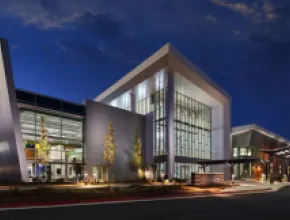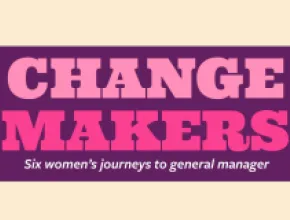Tough times require serious meetings, and dedicated conference centers appear well positioned for what lies ahead.
“Corporations are squeezed. They need to get results quickly—to improve their speed-to-performance. We are positioned to meet that need with an exceptional meetings experience,” says Neil Pompan, CMP, global president of the St. Louis-based International Association of Conference Centers (IACC).
Hal Powell, regional vice president, sales and marketing at Benchmark Hospitality International, a major player in the conference center market, adds that “meeting planners are under pressure and need more than ever to deliver ROI. The perception is that conference centers are for serious, hard-working meetings, and they provide value.”
Dave Arnold, CEO-East for PKF Consulting, who with IACC produces an annual conference center industry trends survey, also believes that conference centers are well placed, especially those at mid level.
“If corporations are trading down, conference centers offer pretty good value,” he says.
A new supply of conference centers, he adds, has been greatly restricted by financial markets, and any new development is likely to be focused on academic and government-subsidized facilities.
“This can only serve to make existing centers more valuable,” he says.
The IACC Advantage
Since 1981, IACC has promoted its own model of the true conference center, a self-contained, distraction-free environment conducive to learning. It has close to 350 member properties worldwide, including 215 in North America. While they range from day centers and corporate and executive facilities with accommodations to resorts, all must adhere to IACC’s “Universal Criteria” for membership.
Purpose-built, the IACC conference center is designed to maximize smaller-meeting productivity. Rules govern a range of aspects from lighting and acoustics to the use of ergonomic chairs.
Pompan, who is vice president at EMCVenues, a meetings management company, emphasizes what he considers to be a big IACC member advantage: efficiency.
“Time remains the most important commodity,” he says.
A hallmark requirement is the Complete Meeting Package (CMP) option that must include lodging (unless the property is a day center), three meals, refreshment breaks, 24-hour meeting room access and audiovisual equipment.
Promoting the IACC difference has not been without continuous challenges. An IACC meeting planner survey conducted last year, for example, found only 50 percent understood the CMP and fewer felt that it had value. Pompan describes this as disturbing, but adds that when the CMP advantages are explained most planners change their views.
Last March, at its 27th annual conference at Zermatt Resort & Spa in Midway, Utah, attended by almost 400 members, IACC unveiled a new branding and logo, including a revamped website at www.iacconline.org.
“IACC as a resource is much more user friendly. The website has lots more meetings specs, enhanced listings and a new map,” says Steve Sackman, IACC’s marketing committee chair.
A program initiated more than a year ago optimizes Google searches for conference centers in major cities, placing IACC properties near the top of the list.
Flag Expansion
Since the last, short-lived recession in 2001 following the dot-com meltdown, IACC’s most notable growth has been in what it terms “ancillary meeting centers.” These are self-contained IACC-certified facilities mostly built as part of expansions and renovations of existing hotels and convention centers that often have larger multipurpose meeting facilities.
IACC requires that the ancillary center be named in such a way as to differentiate it from the property. They are identified in the name of the property, often with the name “executive meeting center” or a similar phrase, and many are at branded hotels.
Under IACC certification in North America, either as ancillary meeting centers or with total meeting space approved by IACC, are 10 Hilton brand properties and nine Doubletrees, seven Marriotts, five Wyndhams and seven Sheratons. IACC recently got its first Westin member and the first Hyatt executive meeting center is planned.
The concept has also been spreading abroad. The group held its first annual European conference last August in the U.K., where it has 24 members. Denmark, for example, has 29 members; Australia, 21.
The Technology Challenge
In its 2008 Top Ten Meetings Trends report, Benchmark addressed “the lighting speed of technological advancement.”
Among its findings: Wireless connectivity is way past being a novelty and is now an expectation, and such technology as 360-degree cams to enable people to be patched in from around the globe is being installed. The use of laptops, which used to be banned in the conference room, was another top 10 trend, but only for note-taking or facilitator research
IACC recently made a long-awaited great leap forward, establishing new technology standards in its Universal Criteria for the first time. Eleven new paragraphs were added that provide the minimum technology requirements necessary for various types and sizes of meeting rooms. (Previously, technology was notably absent; even high-speed Internet was not a requirement.)
According to IACC, which focused mostly on things that members were already doing, they are the basic minimum standard required to ensure the infrastructure and equipment necessary for a successful meeting.
While hotels tend to provide technology on demand, “conference centers don’t wait for the customer to ask for the technology needed to have a productive meeting,” Pompan says.
In October, in addition to announcing the new standards, the group also came out with a 21-page reference paper, “Design for Great Technology,” with recommend guidelines for higher levels of technology.
Members, prospective members and developers, Pompan explains, now have the information they need “to remain in the vanguard of technological advancements and better differentiate themselves from others in the hospitality industry.”
Beginning this year, the new criteria will be part of member audits, which start again this year.
Last year, IACC completed a four-year independent audit of all existing members—the first since its formation—to ensure they were adhering to the criteria.
“This was huge for us. We can now speak with much more confidence,” says Tom Bolman, CAE, IACC’s executive vice president.
Sustainability
Another thing that is huge for IACC, Bolman notes, is sustainability.
“It’s the biggest trend I’ve seen. It is growing tremendously and is gaining momentum among our members. It is no longer just something nice to have,” he says.
IACC has been in the forefront in promoting environmental practices. Awaiting approval by the North America board is a Code of Sustainability drawn up by a task force and expected to come into effect in March. Members signing up for the option will be able to display their own IACC environmental seal.
Last year’s IACC planner survey found that 60 percent of participants ask properties if they are eco-friendly.
With its “Evergreen” program, Benchmark is one of a number of conference center companies with company-wide policies. Destination Hotels & Resorts has the “Destination Earth” initiative; Aramark Harrison Lodging, “Planet Evergreen”; and Dolce Hotels and Resorts, the “Sustainability Program.”
“There really hasn’t been a green standard out there for conference centers. More and more customers are demanding it, and more than half the members are already involved in sustainability programs,” says Leslie Vanderzwet, who chairs IACC’s sustainability committee.
As with other standards, the code will cover such topics as waste management, recycling, purchasing policies, electricity and water savings, and the use of local food products.
Vanderzwet is conference manager at the 414-room Banff Center in Banff, Alberta, which is building a new 23,000-square-foot conference center opening in July 2010.
It is being built to the LEED (Leadership in Energy and Environmental Design) silver standard of the U.S. Green Building Council, a standard that is also being incorporated into the design of new and expanded IACC centers in Georgia, Texas and Florida.
The 198-room Emory Conference Center Hotel, with 26,000 square feet of meeting space at Atlanta’s Emory University campus, which is certified by Green Seal, will unveil a LEED conference center expansion in May that will include 127 new guest rooms and 6,000 square feet of additional meeting space.
Thayer Lodging Group will open a 15,500-square-foot LEED executive meeting center at its 279-room Palm Beach Gardens DoubleTree Hotel in Palm Beach Gardens, Fla., April 1.
Like many of its guest rooms, its meeting space will utilize purification systems from Pure Solutions that are also in place at Thayer’s four other IACC properties, which are under Wyndham and Doubletree flags.
At the University of Texas at Austin, the new AT&T Executive Education and Conference Center opened last August. Managed by Flik Conference Center Management, which operates 13 conference centers, and built to the silver standard, it has 297 guest rooms and 40,000 square feet of meeting space.
Market Trends
In its 2008 conference center industry trends report produced in partnership with IACC, which came out last June, PKF Hospitality found that for conference centers with accommodations, two-thirds of guests attended a conference, followed by leisure guests, then business travelers. Training and continuing education provided the greatest number of conferences.
Full-service hotels provided the biggest competition for IACC centers, followed by other IACC centers, then resorts, day centers and limited-service hotels.
In 2007, conference centers had an average occupancy of 59.2 percent, up 1.5 percent over 2006, at an average daily rate (ADR) of $140.83, up 4.8 percent. Comparable full-service hotels had an average occupancy of 71.3 percent, up 0.5 percent, at an ADR of $155.54, up 6.7 percent.
Arnold wrote then of the challenging times and the feeling of uncertainty over an otherwise generally healthy conference center industry. However, centers were starting to see meetings postponed or canceled, and problems of attrition for meetings held were beginning to appear.
“Meetings are being deferred into 2009, and meetings that are being held are being held at midlevel properties. But so far, we haven’t seen much rate cutting,” he says.
According to Pompan, “Customers began tightening up around September. They typically book training programs then for the next year, but it didn’t happen.”
Adds Benchmark’s Powell: “Our booking production is not far down. Upper-level management meetings are not being canceled. We’ve seen some hesitation at resort properties and for larger sales meetings.”
Sackman, who is regional director of sales and marketing for Denver-based Destination Hotels & Resorts, adds that cancellations are up.
“We’re seeing smaller groups, more short-term bookings. We’ve also seeing programs scaled back and groups are thinking twice about the frills,” he says.





